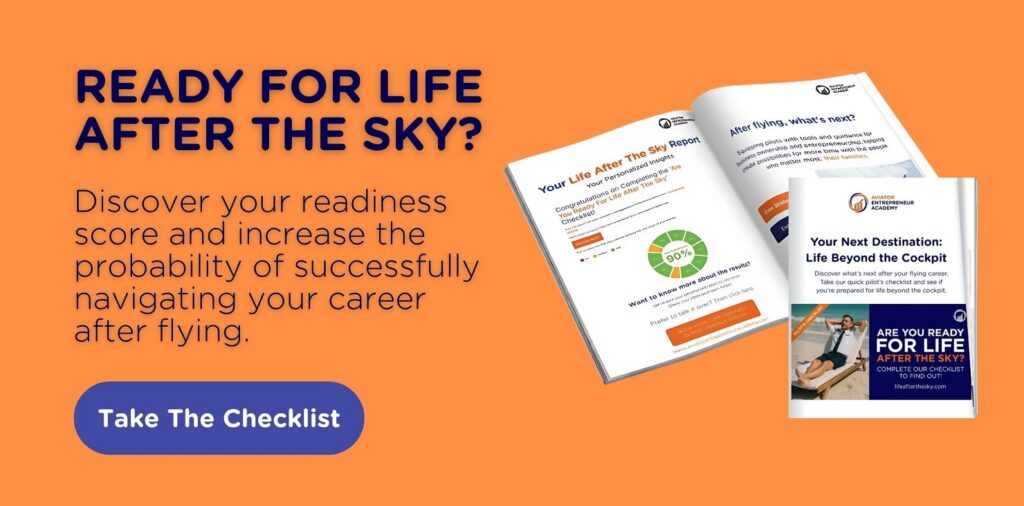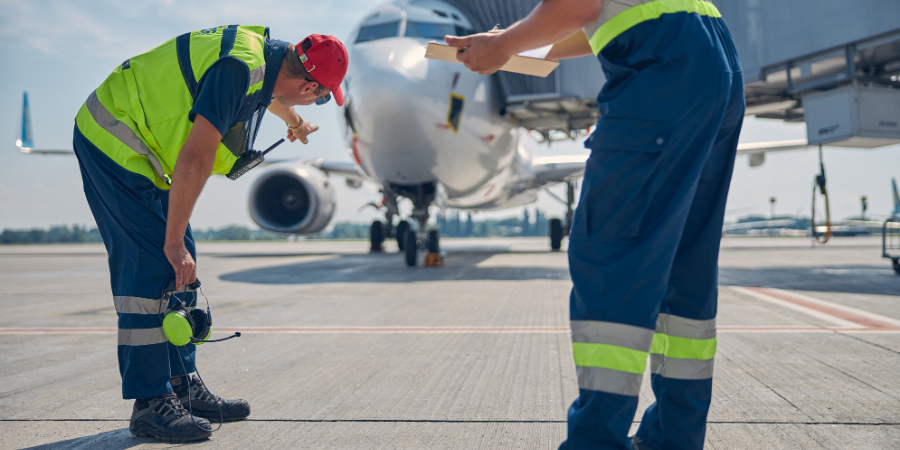Captain. First Officer. Flight Engineer. Navigator. Radio Operator.
Five professionals. One flight.
That was normal back then.
But now, it’s only two. And soon, it might be down to just one.
If you think single-pilot ops and AI-assisted flight decks are decades away, think again. What happened to the flight engineer might just be what’s waiting for the rest of us.
Keep reading to know what’s about to happen.
Key Takeaways
- Flight decks used to be crowded: Early aircraft required 4–5 crew members to fly safely; Captain, FO, Flight Engineer, Navigator, and Radio Operator.
- AI is already in the cockpit: From Airbus ATTOL to Boeing’s AI copilots, major companies are testing and using AI to manage complete phases of flight.
- The shift is happening faster than you think: AI and automation are accelerating the pace of change. Denial won’t stop it; only preparation will.
- Future-proof yourself now: Don’t wait until the second seat is gone, too. Take 3 minutes now to assess your readiness for life after aviation.

The Historical Evolution of the Flight Deck
There was a time when the flight deck was standing room only. You had your Captain and First Officer, of course.
But right behind them sat the Flight Engineer, a Navigator and the Radio Operator.
At that time, every one of those crew members was essential. This was the norm aboard aircrafts like the Boeing 707, the DC-8, and the early 747s.
Then the machines started getting smarter.
Cutting Down the Crew
The shift started quietly in the 1970s. Aircraft like the Boeing 727 and Airbus A300 introduced more integrated systems. Suddenly, flight engineers no longer managing bleed air or fuel balancing with a clipboard.
However, the real game changer was FADEC (Full Authority Digital Engine Control).
FADEC systems took over complex engine management with more speed, precision, and consistency than any human could deliver.
By the mid-1980s, aircraft like the Boeing 767, McDonnell Douglas MD-80, and Airbus A310 were being designed from the ground up for two-person crews.
The third seat was gone.
Here’s a question we should ask ourselves now: “If the third seat disappeared that quickly, what makes us think the second is untouchable?”
The Resistance & Denial Phase
The removal of the flight engineer wasn’t smooth. It wasn’t welcomed. And it definitely wasn’t unopposed. Similarly, the more recent push toward single-pilot operations has sparked another wave of opposition. One of the strongest voices against it has been the European Cockpit Association, which launched the “One Means None” campaign to raise awareness.
Unions Fought Back
When aircraft manufacturers and regulators started designing two-crew cockpits in the 1970s and ‘80s, flight engineers saw the writing on the wall.
They didn’t like what it said.
Moreover, ALPA (Air Line Pilots Association) and IFALPA (International Federation of Air Line Pilots’ Associations) rallied hard to delay or prevent the changes. They argued that three-crew operations were critical for safety.
But to no avail, as the momentum of technology was unstoppable.
The Language Was Familiar
If you read old issues of ECA’s position papers or archived ALPA magazines from the late ’70s and early ‘80s, the arguments from the Flight Engineer side sound eerily familiar:
- “Removing the third crew member compromises safety.”
- “Automation increases workload, not reduces it.”
- “When systems fail, humans need to be in control.”
Sounds like something you’ve heard recently?
Denial as a Coping Mechanism
Here’s the uncomfortable truth: most flight engineers didn’t believe they’d be replaced.
They believed their operational knowledge, redundancy role, and technical skill made them irreplaceable.
Automation, however, did not request authorization. It was proving itself in service, and airlines were watching the numbers; lower training costs and less weight.
In the end, resistance didn’t stop the shift. It only delayed adaptation.
History is now repeating itself.
But are we learning from our past? Or just making the same mistake?
Now It’s Happening Again, But Faster
If you think what happened to the Flight Engineer is ancient history, think again. This time it’s not the third seat in question, it’s the second.
Major Players Are Already Moving
This is not something “a startup might try one day.”
It’s already being developed, funded, tested, and trialed by the biggest names in aerospace. These include:
1. Airbus: Project ATTOL
Airbus’ Autonomous Taxi, Takeoff and Landing (ATTOL) program completed its first full gate-to-gate autonomous flight in 2020 using AI-driven computer vision.
“Autonomy will play a growing role in aviation. Not in the future. Now.” ~ Airbus ATTOL program lead engineer
2. Boeing: AI in the Cockpit
Boeing is quietly advancing AI-first cockpits, especially through HorizonX ventures. These systems aren’t just offering checklists or alerts; they’re making decisions, simulating pilot judgment, and preparing for fully autonomous support in emergencies.
Boeing’s engineers refer to these systems as “co-pilots that don’t blink.”
3. Dassault Falcon AI Copilot Tech
Dassault’s business jets are now showcasing AI-assisted workload sharing. This is where the system prioritizes tasks, manages navigation, and prepares the aircraft for various phases of flight independently.
Regulators Are in the Loop, Not Behind
This time around, regulatory bodies aren’t playing catch-up; they’re actively involved. However, pilot unions have sounded concerns and are determined to prevent it from happening again.
The authorities that are actively working on a one-crew flight include:
1. EASA
European authorities have been testing frameworks for Reduced Crew Operations (RCO) since 2021. They anticipate a shift to single-pilot commercial operations by the early 2030s, or possibly sooner, on short-haul and cargo flights.
2. FAA
The FAA, in coordination with NASA, is exploring Human-AI Teaming protocols and certification baselines for autonomous support systems.
The Endowment Effect at Play
As pilots, we like control. We’re trained for it and paid for it. Whether we admit it or not, we trust systems only up to the point they don’t threaten our seat.
So, when conversations about AI and single-pilot operations surface, what do we say?
“Not in my career.”
If that sounds familiar, you’re not alone.
Behavioral Economics 101
In psychology, there’s a well-documented bias called the Endowment Effect. It’s the tendency to overvalue things simply because we already possess them.
For pilots, the “thing” we overvalue is the current model of flight ops.
It feels right.
But just because something feels permanent doesn’t mean it is. Ask the guy who used to ride shotgun with a clipboard full of VOR radials.
Visual Parallel: From Horses to Cars in NYC (1900–1913)
For perspective, let’s just step out of the cockpit for a moment.
In the year 1900, New York City had over 100,000 horses. They powered delivery carts, pulled cabs, and even handled emergency response.
However, thirteen years later, they were gone.
By 1913, cars had completely taken over Manhattan. The horses weren’t phased out across generations, they were replaced in a single decade.
We Don’t Have 13 Years Anymore
That transformation occurred without the aid of AI, real-time data, cloud-based machine learning, or billion-dollar aviation startups pushing automation.
Today, everything moves faster.
What took 13 years in 1900 could now take only 5.
So, it’s important that we’re ready for this change, as it can happen in the blink of an eye without anyone realizing it has come.
Don’t Wait Until You’re Obsolete – Take the Leap
Flight engineers didn’t see it coming until it was too late. And now pilots are facing the same risk. AI, automation, and single-pilot ops aren’t theories; they’re already reshaping the industry.
The question isn’t if, it’s when and more importantly, if you’re ready for this change.
Most pilots don’t think about life after aviation… until they’re grounded. By then, options are fewer. Confidence is lower, and time’s already ticking.
But you don’t have to wait for that.
If you’ve got 3 minutes, take this quiz to find out how prepared you really are for life after aviation. You might be more ready, or more vulnerable, than you think.
Invitation to join our FREE Strategy Session
Most pilots are one honest conversation away from clarity. This is that conversation.
Complete our “Life After the Sky” checklist, then join me for a FREE 15-minute “Strategy Session” via Zoom.
This session has been created for pilots who want to take ownership of what comes next.
Those who want action, not just to talk about it.
In just 15 minutes, we’ll:
- Review your checklist results
- Identify the one obstacle holding back your reinvention
Translate your checklist results into a clear starting point
Start your pre-flight assessment for the next chapter of your journey by Booking your free strategy session here!



